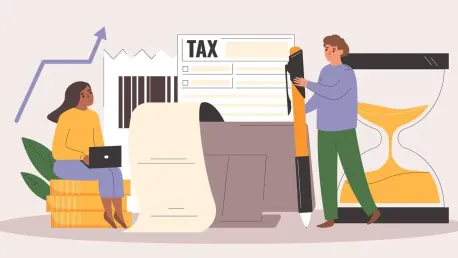The recent tax-cut proposal put forth by South Carolina Republican leaders has sparked significant interest and debate across the state. By transitioning to a flat tax rate structure, proponents believe the state could enhance its economic attractiveness and competitiveness. However, the implications of these changes are multifaceted, warranting a closer look at various aspects of the proposal.
The Proposal: Simplifying and Reducing Taxes
The core of the plan involves lowering the state’s current tax rates and introducing a single, flat tax rate of 3.99% starting January 1, 2026. This is a substantial reduction from the present top rate of 6.2%, aiming to simplify the tax code and make it more predictable for taxpayers. This simplification is expected to result in a cleaner, more accessible system, facilitating easier compliance and reducing administration costs for both taxpayers and the government.
As part of an incremental approach, the proposal also includes a provision to potentially reduce the flat rate even further, targeting a 2.49% rate depending on future revenue growth. This conditional timeline suggests a phased approach to ensure revenue stability and gradual adjustment. Such a stepwise reduction not only cushions the financial impact but also allows legislators to monitor and address potential economic fallout meticulously.
Goals and Competitive Edge
One of the primary objectives of this plan is to bolster South Carolina’s economic competitiveness, particularly when compared to neighboring states with lower tax rates. By presenting a lower tax burden, the state hopes to attract new businesses and residents seeking a more favorable economic environment. Lower tax rates can be a powerful enticement, drawing businesses looking to maximize profitability and individuals desiring more disposable income.
Republican leaders argue that simpler tax structures can often be more enticing for individuals and enterprises evaluating relocation or expansion opportunities. The perception of a reduced “sticker shock” could make South Carolina more appealing in the southeastern United States. A predictable, low tax rate removes one significant variable in an enterprise’s decision-making process, potentially encouraging long-term investments and stimulating economic activity.
Broader Tax Base and Adjustments
A key aspect of the proposal is broadening the tax base. By shifting from the federal taxable income model to adjusted gross income, more taxpayers will be included in the tax system. This alignment with the tax models of most other states ensures a more comprehensive approach to tax collection. By encompassing a wider range of taxpayers, the state aims to distribute the tax burden more evenly, potentially increasing overall state revenues while simultaneously lowering individual rates.
This change addresses the current situation where a significant percentage of tax filers pay no state income tax. The new system seeks to ensure that all residents contribute, potentially increasing state revenues while also lowering individual rates. Under this revamped structure, high earners are still contributing a larger share, but the overall rate is more manageable, providing a sense of fairness and inclusivity in tax collection.
Balancing Economic Impact and Fairness
The proposal has met with both support and caution. Proponents assert that the tax cuts will attract businesses, spur job creation, and bolster economic growth while being beneficial for families. Reduced tax burdens can spur innovation and entrepreneurship as businesses find it easier to start and grow, leading to a virtuous cycle of economic growth and opportunities. However, critics voice concerns regarding the potential regressive nature of a flat tax and its impact on lower-income residents.
The challenge lies in finding a balance that ensures the plan’s fairness across all income levels. Introducing personal exemptions for low-income filers and retaining existing benefits for specific groups like military families and senior citizens is a step towards mitigating adverse effects. Ensuring that these vulnerable groups are protected and not disproportionately burdened by the tax changes is crucial for broader public acceptance and long-term sustainability of the policy.
Revenue and Fiscal Stability
While the predicted nominal rate cut is substantial, the proposal is designed with fiscal stability in mind. The plan’s phased reductions aim to ensure that state revenues are not drastically impacted all at once, with adjustments contingent on revenue growth. This measured approach permits the state to maintain essential services while gradually shifting to the new tax framework, thus avoiding sudden fiscal shocks.
House Ways and Means Chairman Bruce Bannister highlights the importance of a measured approach to ensure fiscal stability, indicating that the state is cautious about implementing changes that could potentially compromise essential services. By staggering the reductions and closely monitoring fiscal impacts, the state aims to strike a careful balance between fostering economic growth and maintaining robust public services.
Initial Legislative Reactions
As with any significant policy proposal, initial reactions have been mixed. Republican leaders and the state Chamber of Commerce have expressed strong support, emphasizing the potential economic advantages and simplified structure. They argue that such measures are necessary to invigorate the economy and make South Carolina a more attractive destination for business investments and professionals seeking a favorable tax environment.
Democratic lawmakers, however, are approaching the plan with caution. They are awaiting detailed fiscal projections and voicing concerns about the potential shortfall in revenues that could affect essential state services or disproportionately burden lower-income residents. This prudent approach ensures that potential pitfalls are considered and addressed, aiming for a balanced and equitable implementation of the new tax system.
Long-term Economic Vision
The overarching vision behind the tax-cut proposal is to create a more competitive and attractive economic environment in South Carolina. By reducing the perceived tax burden, the state plans to draw new businesses and provide more opportunities for job creation and higher wages. This strategy reflects broader economic trends where states with lower and predictable tax rates often see more robust business growth and entrepreneurial activity.
Ultimately, this strategy reflects a broader trend towards tax simplification and economic growth. The proposal represents a significant shift in South Carolina’s tax policy, with the potential to reshape the state’s economic landscape in the years to come. By aligning with competitive tax practices and promoting an inclusive tax base, the state hopes to sustain a growing, prosperous economy that benefits all residents.
A Path Forward for South Carolina
The new tax-cut proposal from South Carolina Republican leaders has generated considerable discussion and interest throughout the state. This plan, which introduces a flat tax rate structure, aims to make the state’s economy more attractive and competitive. Proponents argue that simplifying the tax system could draw businesses and individuals to South Carolina, potentially boosting economic growth. However, the potential consequences of such changes are complex and call for an in-depth examination of all aspects of the proposal.
Critics worry that a flat tax rate could disproportionately benefit higher-income individuals while placing a greater financial burden on lower-income residents. There is also concern about how the shift to a flat tax might affect public services funded by the current progressive tax system. As the debate continues, stakeholders from various sectors are weighing in, underscoring the need for a thorough and careful analysis of the proposal’s broad effects on South Carolina’s fiscal landscape and its residents’ financial well-being.









